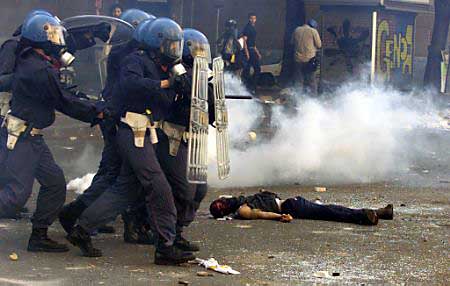
Police unions are out of control.
Earlier this year, Baltimore cops murdered Freddie Gray by chaining him up and intentionally swerving and repeatedly slamming on the breaks. Rather than telling their members to behave professionally, however, the head of the city’s police union attacked people who protested Gray’s death, smearing them as — of all things! — “a lynch mob.”
About a year ago, the leader of New York’s police union reacted to the assassination of two Brooklyn cops as they sat in their squad car by declaring that newly-elected mayor Bill de Blasio had “blood on his hands” — because he hadn’t been sufficiently pro-cop. (There is no evidence that the killer ever heard of Bill de Blasio.)
Now the Fraternal Order of Police is threatening one of the United States’ most acclaimed film directors.
FOP executive director Jim Pasco, threatened Quentin Tarantino, who helmed “Pulp Fiction” and numerous other major movies, in The Hollywood Reporter. “Something is in the works, but the element of surprise is the most important element. Something could happen anytime between now and (the premiere). And a lot of it is going to be driven by Tarantino, who is nothing if not predictable. The right time and place will come up and we’ll try to hurt him in the only way that seems to matter to him, and that’s economically.”
Charming.
Tarantino’s “crime,” in the eyes of “there’s blue, then there’s you” cops: he attended a Black Lives Matter rally, where he said he was against murderers, and for the murdered.
There’s only one logical inference. According to the police, Black Lives Do Not Matter. By their wicked logic, we should support murderous cops, not murdered civilians.
If you don’t toe the line? “Instead of dealing with the incidents of police brutality that those people were bringing up, instead of examining the problem of police brutality in this country, better they single me out,” Tarantino told The Los Angeles Times. “And their message is very clear. It’s to shut me down. It’s to discredit me. It is to intimidate me. It is to shut my mouth, and even more important than that, it is to send a message out to any other prominent person that might feel the need to join that side of the argument.”
Jacobin magazine’s description of these organizations as “The Bad Kind of Unionism” is putting it mildly. The only people they “protect and serve” is themselves — the people be damned.
It’s ironic that that Tarantino quote comes from the LA Times. The Times, you see, is owned by Tribune Publishing. Whose number-one shareholder is a private equity firm called Oaktree Capital. Which manages the pension fund of the LAPD police union, the LAPPL (Police Protective League).
The LAPPL is one of the free-speech-hating fascist police unions threatening Tarantino. And the LAPPL appears to have gotten the Times to fire me as its political cartoonist — using quickly-discredited evidence — because I criticized the LAPD for the fact that they’re violently militarized and lousy at their jobs.
After I was fired, the LAPPL issued a press release. “So many within the LAPD were pleasantly surprised at the recent firing of Los Angeles Times opinion cartoonist Ted Rall,” the union said. “We hope other news publications will take note…” (They removed it from the Internet after the outcry over my firing.)
When you’re a hammer, everything looks like a nail. That’s cops in the year 2015. They want to shoot and torture and rob and harass us. Without fear of punishment.
They can’t even stand criticism.
So they go after cartoonists. And film directors.
Reporters, too.
A former journalist — the “former” comes courtesy of the cops who leaned on his cowardly excuse for an editor to fire him — in Baker City, Oregon is suing Baker City and its freedom-hating police chief for making his life miserable. After the Baker City Record-Courier let Brian Addison go as a favor to Baker City PD in 2008, the cops followed his car around, repeatedly stopping him. When he landed another job, not in journalism, in 2014, the cops got him fired again — using a falsified “dossier” that indicated he had a criminal background. He didn’t.
What did Addison do to piss off the po-po?
He wrote an editorial complaining about an incident at a high school girls basketball game, where the fuzz walked a drug-sniffing dog through the stands during halftime. Addison’s editorial pointed out, correctly, that this was a disgusting violation of basic Fourth Amendment rights against unreasonable searches.
Unions are an essential bulwark against gangster capitalism. Public-sector unions are just as necessary as private-sector ones. But these police — and their unions — have got to go.
Every police department in the country should be disbanded. All the cops should be fired. It’s time to start from scratch — and replace them with civilian-run organizations designed to protect us.
(Ted Rall, syndicated writer and the cartoonist for ANewDomain.net, is the author of the new book “Snowden,” the biography of the NSA whistleblower. Want to support independent journalism? You can subscribe to Ted Rall at Beacon.)
COPYRIGHT 2015 TED RALL, DISTRIBUTED BY CREATORS.COM

